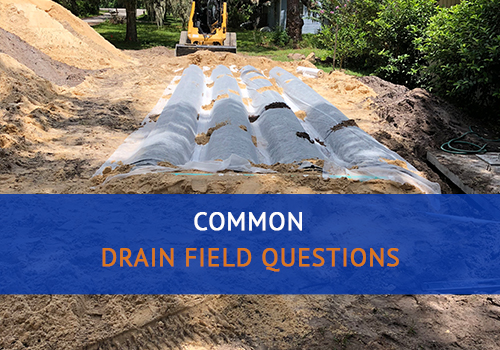Drain fields. We talk about them a lot in terms of maintenance, but how much do you think about yours on a daily basis? Chances are minimal.
Florida has many rules and regulations for your septic system, including the drain field.
But, this doesn’t mean you don’t have a stack of drain field questions built up. Let’s take a moment to read through some of our drain field FAQs. You may have some of the same questions.

Common Drain Field Questions
What is a Drain Field?
A drainfield is a major part of your septic system. It consists of several, perforated pipes, which help release the wastewater coming from the septic tank.
The holes in the pipes are small enough to let liquid without letting any solid waste out. From here, the wastewater is filtered and released back into the ground. The drain field is the last step in removing impurities from the septic water.
Are all Drainfields Made the Same?
No. Depending on the property, the location, shape, and size of the drain fields (and septic system size) will vary.
Drain fields can also be made of different materials like soil, gravel, and sand.
What’s the Difference Between Drain Fields and Leach Fields?
This is one of the easier drain field questions to answer.
Nothing. A drain field and a leach field are the same thing. You may even hear the term leach drain used.
How Big are Drain Fields?
Depends on your property. If you have a large septic system, then your drain field will have to be big enough to support it.
How Do I Locate My Property’s Drainfield?
Start by taking a look at your property. Since drain fields are different depending on the needs of every septic system, they could look different. Maybe your drain field shows the depressions from the underground pipes. Or, perhaps you notice a larger area of land that is covered with sand or gravel.
It’s not always easy to exactly locate your property’s drain field. Therefore, we suggest contacting a professional technician to help you locate the drainfield. They will be able to help you find its location, size, and make-up.
Can I Build On Top of My Drain Field?
No!
Placing anything on top of your drain field is dangerous. Because you can’t see what’s underground, you could easily damage pipes while excavating or digging.
The drain field seems like a great place to put a new carport or a slab of cement to park your camper on top of. Again, don’t do this.
Not only is the weight a problem, but so is covering up the ground with materials like concrete. Building something like this on top of your drain field will become a significant problem when it comes time for maintenance or repairs.
Can I Plant Around My Drain Field?
This is one of our most frequently asked drain field questions.
And the answer is, it depends.
Anything that grows deep roots is not acceptable. These types of plants can cause significant damage to your underground septic system, including the drain field pipes.
Anything that requires a substantial amount of water should not be anywhere near your drain field. A lot of water means flooding. Too much water in your drain field indicates that the soil or gravel cannot absorb and filter the wastewater like it is expected to.
Never plant any vegetables on your drain field. Even if you’re sure that you won’t damage your drain field, you don’t want to risk contaminating any food you consume. Septic contamination is hazardous.
You must be aware of your drain field. If you dig too deep to plant vegetation or flowers, you could end up breaking the drain field pipes.
Encountering any of these problems means you’ll have to contact your septic professional. This usually means money and time.
How Do I Make Sure My Drain Field Lasts?
Regular maintenance is key. Here are a few quick review tips that may help you extend the life of your drain field.
- Schedule annual inspections with your septic technician.
- Conserve your household water. This is an excellent idea to the environment and to keep your drain field from flooding.
- Don’t do any landscaping or construction without considering your drain field.
- Keep anything substantial off of the drain field. This includes cars, boats, and motorhomes.
Drain fields are an essential part of your septic system, making drain field questions common.
Your drain field is the final place that your septic wastewater goes. You want to ensure that your drain field is in tip-top shape. So, if you have questions regarding your specific drain field, give us a call at Advanced Septic Services.

